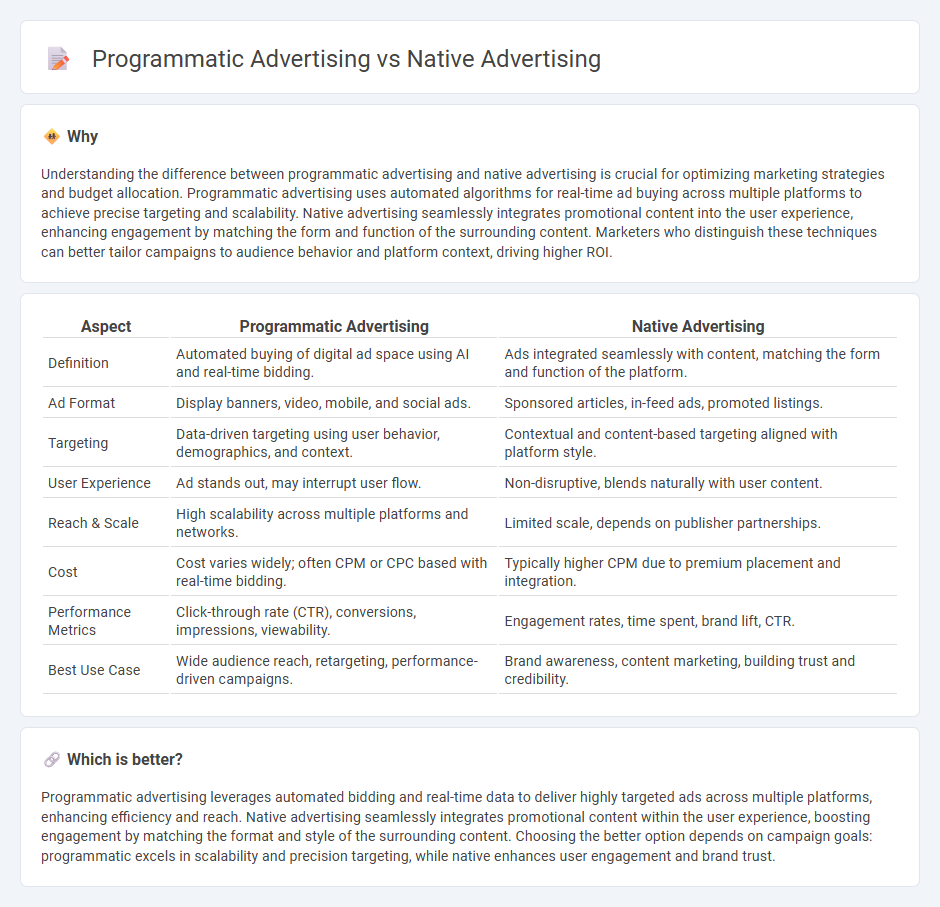
Programmatic advertising uses automated technology and real-time bidding to place ads across various digital channels, targeting specific audiences with precision and efficiency. Native advertising seamlessly integrates promotional content into the user experience, matching the format and style of the platform to enhance engagement and reduce ad fatigue. Discover the unique advantages and applications of programmatic and native advertising to elevate your marketing strategy.
Why it is important
Understanding the difference between programmatic advertising and native advertising is crucial for optimizing marketing strategies and budget allocation. Programmatic advertising uses automated algorithms for real-time ad buying across multiple platforms to achieve precise targeting and scalability. Native advertising seamlessly integrates promotional content into the user experience, enhancing engagement by matching the form and function of the surrounding content. Marketers who distinguish these techniques can better tailor campaigns to audience behavior and platform context, driving higher ROI.
Comparison Table
| Aspect | Programmatic Advertising | Native Advertising |
|---|---|---|
| Definition | Automated buying of digital ad space using AI and real-time bidding. | Ads integrated seamlessly with content, matching the form and function of the platform. |
| Ad Format | Display banners, video, mobile, and social ads. | Sponsored articles, in-feed ads, promoted listings. |
| Targeting | Data-driven targeting using user behavior, demographics, and context. | Contextual and content-based targeting aligned with platform style. |
| User Experience | Ad stands out, may interrupt user flow. | Non-disruptive, blends naturally with user content. |
| Reach & Scale | High scalability across multiple platforms and networks. | Limited scale, depends on publisher partnerships. |
| Cost | Cost varies widely; often CPM or CPC based with real-time bidding. | Typically higher CPM due to premium placement and integration. |
| Performance Metrics | Click-through rate (CTR), conversions, impressions, viewability. | Engagement rates, time spent, brand lift, CTR. |
| Best Use Case | Wide audience reach, retargeting, performance-driven campaigns. | Brand awareness, content marketing, building trust and credibility. |
Which is better?
Programmatic advertising leverages automated bidding and real-time data to deliver highly targeted ads across multiple platforms, enhancing efficiency and reach. Native advertising seamlessly integrates promotional content within the user experience, boosting engagement by matching the format and style of the surrounding content. Choosing the better option depends on campaign goals: programmatic excels in scalability and precision targeting, while native enhances user engagement and brand trust.
Connection
Programmatic advertising leverages automated technology to buy and optimize ad space in real-time, enhancing the delivery efficiency of native advertising, which seamlessly integrates promotional content within the user experience. Native advertising benefits from programmatic platforms by targeting specific audiences more precisely, increasing engagement rates through contextually relevant ads that match the surrounding content. This synergy drives higher ROI by combining the scalability of programmatic buying with the non-disruptive, content-aligned appeal of native ads.
Key Terms
Content Integration
Native advertising seamlessly blends promotional content into the platform's natural user experience, ensuring high engagement through personalized storytelling and contextually relevant messaging. Programmatic advertising uses automated bidding and data-driven targeting to deliver ads across multiple channels, optimizing reach and efficiency based on user behavior and demographics. Explore the key differences in content integration strategies to enhance your marketing campaigns.
Automated Buying
Automated buying in programmatic advertising uses algorithms and real-time bidding to optimize ad placements across digital platforms, ensuring precise targeting and efficient budget utilization. In contrast, native advertising integrates promotional content seamlessly within editorial feeds, enhancing user engagement without disrupting the browsing experience. Explore the benefits and technologies behind automated buying to elevate your advertising strategy.
Audience Targeting
Native advertising integrates promotional content seamlessly within platform environments, leveraging contextual relevance to engage specific audience segments through tailored storytelling. Programmatic advertising utilizes real-time bidding algorithms and extensive data analytics to deliver highly precise audience targeting based on demographics, behavior, and interests across various digital channels. Explore more about how each strategy enhances audience targeting effectiveness and campaign ROI.
Source and External Links
What is Native Advertising - How it Works - Outbrain - Native advertising is a paid advertising format where ads blend in with the look, feel, and function of the media they appear on, aiming to engage consumers with original, high-quality content that feels natural rather than intrusive.
What is native advertising? - Adjust - Native advertising is paid media that matches the visual design and function of the platform, delivering higher engagement rates, improved user retention, better ROI, and often can bypass ad blockers, making it a highly effective marketing tool.
Native Advertising: How It Works, Types, Benefits - Taboola.com - Native advertising works by blending paid content seamlessly into editorial contexts, leveraging programmatic advertising auctions to place highly relevant ads that drive awareness, clicks, and conversions across many industries.
 dowidth.com
dowidth.com